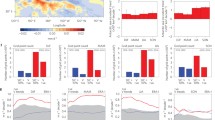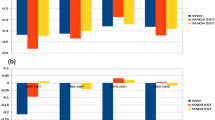Abstract
During 1979–2014, eastern tropical Pacific sea surface temperatures significantly cooled, which has generally been attributed to the transition of the Pacific Decadal Oscillation to its negative phase after 1999. We find the eastern tropical Pacific cooling to be associated with: (1) an intensified Walker Circulation during austral summer (December–February, DJF) and autumn (March–May, MAM); (2) a weakened South Pacific Hadley cell and subtropical jet during MAM; and (3) a strengthening of the circumpolar westerlies between 50 and 60°S during DJF and MAM. Observed cooling in the eastern tropical Pacific is linearly congruent with 60–80 % of the observed Southern Hemisphere positive zonal-mean zonal wind trend between 50 and 60°S during DJF (~35 % of the interannual variability), and around half of the observed positive zonal-mean zonal wind trend during MAM (~15 % of the interannual variability). Although previous studies have linked the strengthened DJF and MAM circumpolar westerlies to stratospheric ozone depletion and increasing greenhouse gases, we note that the continuation of the positive SAM trends into the twenty-first century is partially associated with eastern tropical Pacific cooling, especially during MAM when zonal wind anomalies associated with eastern tropical Pacific cooling project strongly onto the observed trends. Outside of DJF and MAM, eastern tropical Pacific cooling is associated with opposing zonal wind anomalies over the Pacific and Indian sectors, which we infer is the reason for the absence of significant positive SAM trends outside of DJF and MAM despite significant eastern tropical Pacific cooling seen during all seasons.














Similar content being viewed by others
References
Arblaster JM, Meehl GA (2006) Contributions of external forcings to southern annular mode trends. J Clim 19:2896–2905
Bracegirdle TJ (2012) Climatology and recent increase of westerly winds over the Amundsen Sea derived from six reanalyses. Int J Climatol 33:843–851
Bracegirdle TJ, Marshall GJ (2012) The reliability of Antarctic tropospheric pressure and temperature in the latest global reanalyses. J Clim 25:7138–7146
Bromwich DH, Nicolas JP, Monaghan AJ (2011) An assessment of precipitation changes over Antarctica and the Southern Ocean since 1989 in contemporary global reanalyses. J Clim 24:4189–4209
Clem KR, Fogt RL (2015) South Pacific circulation changes and their connection to the tropics and regional Antarctic warming in austral spring, 1979–2012. J Geophys Res Atmos. doi:10.1002/2014JD022940
Codron F (2005) Relation between annular modes and the mean state: southern hemisphere summer. J Clim 18:320–330
Cohen J, Cohen P (1983) Applied Multiple Regression/Correlation Analysis for the Behavioral Sciences. Taylor & Francis, Routledge
Dee DP et al (2011) The ERA-Interim reanalysis: configuration and performance of the data assimilation system. Q J R Meteorol Soc 137:553–597
Ding Q, Steig EJ (2013) Temperature change on the Antarctic Peninsula linked to the tropical Pacific. J Clim 26:7570–7585
Ding Q, Steig DJ, Battisti DS, Wallace JM (2012) Influence of the tropics on the southern annular mode. J Clim 25:6330–6348
England MH, McGregor S, Spence P, Meehl GA, Timmermann A, Cai W, Sen Gupta A, McPhaden MJ, Purich A, Santoso A (2014) Recent intensification of wind-driven circulation in the Pacific and the ongoing warming hiatus. Nat Clim Chang 4:222–227
Feldstein S, Lee S (1998) Is the atmospheric zonal index driven by an eddy feedback? J Atmos Sci 55:3077–3086
Fogt RL, Bromwich DH (2006) Decadal variability of the ENSO teleconnection to the high latitude South Pacific governed by coupling with the southern annular mode. J Clim 19:979–997
Fogt RL, Bromwich DH, Hines KM (2011) Understanding the SAM influence on the South Pacific ENSO teleconnection. Clim Dyn 36:1555–1576
Fogt RL, Jones JM, Renwick JA (2012) Seasonal zonal asymmetries in the southern annular mode and their impact on regional temperature anomalies. J Clim 25:6253–6270
Folland CK, Renwick JA, Salinger MJ, Mullan AB (2002) Relative influences of the interdecadal Pacific oscillation and ENSO on the South Pacific convergence zone. Geophys Res Lett. doi:10.1029/2001GL014201
Fyfe JC, Lorenz DJ (2005) Characterizing midlatitude jet variability: lessons from a simple GCM. J Clim 18:3400–3404
Gillett NP, Thompson DWJ (2003) Simulation of recent Southern Hemisphere climate change. Science 302:273–275
Gong T, Feldstein SB, Luo D (2010) The impact of ENSO on wave breaking and southern annular mode events. J Atmos Sci 67:2854–2870
Gong T, Feldstein SB, Luo D (2013) A simple GCM study on the relationship between ENSO and the southern annular mode. J Atmos Sci 70:1821–1832
Karoly DJ (1989) Southern hemisphere circulation features associated with El niño-southern oscillation events. J Clim 2:1239–1252
Kidson JW (1999) Principal Modes of Southern Hemisphere low-frequency variability obtained from NCEP–NCAR reanalyses. J Clim 12:2808–2830
Kosaka Y, Xie S-P (2013) Recent global-warming hiatus tied to equatorial Pacific surface cooling. Nature 501:403–407
Kucharski F, Ikram F, Molteni F, Farneti R, Kang I-S, No H-H, King MP, Giuliani G, Mogensen K (2016) Atlantic forcing of Pacific decadal variability. Clim Dyn 46:2337–2351
L’Heureux ML, Thompson DWJ (2006) Observed relationships between the El-Niño/Southern Oscillation and the extratropical zonal-mean circulation. J Clim 19:276–287
Limpasuvan V, Hartmann DL (1999) Eddies and the annular modes of climate variability. Geophys Res Lett 26:3133–3136
Lorenz DJ, Hartmann DL (2001) Eddy-zonal flow feedback in the Southern Hemisphere. J Atmos Sci 58:3312–3327
Mantua NJ, Hare SR (2002) The Pacific decadal oscillation. J Oceanogr 58:25–44
Marshall GJ (2003) Trends in the southern annular mode from observations and reanalyses. J Clim 16:4134–4143
McGregor S, Timmermann A, Stuecker MF, England MH, Merrifield M, Jin FF, Chikamoto Y (2014) Recent walker circulation strengthening and Pacific cooling amplified by Atlantic warming. Nat Clim Chang. doi:10.1038/NCLIMATE2330
Meehl GA, Hu A, Arblaster JM, Fasullo JY, Trenberth KE (2013) Externally forced and internally generated decadal climate variability associated with the Interdecadal Pacific Oscillation. J Clim 26:7298–7310
Miller RL, Schmidt GA, Shindell DT (2006) Forced annular variations in the 20th century intergovernmental panel on climate change fourth assessment report models. J Geophys Res 111:D18101. doi:10.1029/2005JD006323
Mo KC, Higgins RW (1998) The Pacific-South American modes and tropical convection during the Southern Hemisphere winter. Mon Wea Rev 126:1581–1596
Nakamura H, Shimpo A (2004) Seasonal variations in the Southern Hemisphere storm tracks and jet streams as revealed in a reanalysis dataset. J Clim 17:1828–1844
Oort AH, Jienger JJ (1996) Observed interannual variability in the Hadley circulation and its connection to ENSO. J Clim 9:2751–2767
Peixoto JP, Oort AH (1992) Physics of Climate. American Institute of Physics, College Park
Polvani LM, Waugh DW, Correa GJP, Son SW (2011) Stratospheric ozone depletion: the main driver of twentieth-century atmospheric circulation changes in the Southern Hemisphere. J Clim 24:795–812
Rayner NA, Parker DE, Horton EB, Folland CK, Alexander LV, Rowell DP, Kent EC, Kaplan A (2003) Global analyses of sea surface temperature, sea ice, and night marine air temperature since the late nineteenth century. J Geophys Res. doi:10.1029/2002JD002670
Rogers JC, van Loon H (1982) Spatial variability of sea level pressure and 500 mb height anomalies over the Southern Hemisphere. Mon Wea Rev 110:1375–1392
Schneider D, Deser C, Fan T (2015) Comparing the impacts of tropical SST variability and polar stratospheric ozone loss on the Southern Ocean westerly winds. J Clim 28:9350–9372
Seager R, Harnik N, Kushnir Y, Robinson W, Miller J (2003) Mechanisms of hemispherically symmetric climate variability. J Clim 16:2960–2978
Son SW et al (2010) Impact of stratospheric ozone on Southern Hemisphere circulation change: a multimodel assessment. J Geophys Res Atmos. doi:10.1029/2010JD014271
Swart NC, Fyfe JC, Gillett N, Marshall GJ (2015) Comparing trends in the southern annular mode and surface westerly jet. J Clim 28:8840–8859
Thompson DWJ, Solomon S (2002) Interpretation of recent Southern Hemisphere climate change. Science 296:895–899
Thompson DWJ, Wallace JM (2000) Annular modes in the extratropical circulation. Part I: Month-to-month variability. J Clim 13:1000–1016
Thompson DWJ, Wallace JM, Hegerl GC (2000) Annular modes in the extratropical circulation. Part II: trends. J Clim 13:1018–1036
Trenberth KE, Fasullo JT (2013) An apparent hiatus in global warming? Earth’s Future 1:19–32. doi:10.1002/2013EF000165
Trenberth KE, Fasullo JT, Branstator G, Phillips AS (2014) Seasonal aspects of the recent pause in surface warming. Nat Clim Chang 4:911–916
Zhang W, Li J, Zhao X (2010) Sea surface temperature cooling mode in the Pacific cold tongue. J Geophys Res. doi:10.1029/2010JC006501
Acknowledgments
Two anonymous reviewers are thanked for their comments that helped us improve our main points. The European Centre for Medium-Range Weather Forecasts is acknowledged for providing ERA-Interim data, which was accessed freely online at http://apps.ecmwf.int/datasets/data/interim_full_moda). The Met Office Hadley Centre is acknowledged for providing SST data, also accessed freely online at http://www.metoffice.gov.uk/hadobs/hadisst/). KRC is supported by a Victoria University Doctoral Scholarship.
Author information
Authors and Affiliations
Corresponding author
Rights and permissions
About this article
Cite this article
Clem, K.R., Renwick, J.A. & McGregor, J. Relationship between eastern tropical Pacific cooling and recent trends in the Southern Hemisphere zonal-mean circulation. Clim Dyn 49, 113–129 (2017). https://doi.org/10.1007/s00382-016-3329-7
Received:
Accepted:
Published:
Issue Date:
DOI: https://doi.org/10.1007/s00382-016-3329-7




